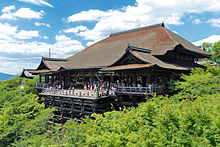
Back السياحة في اليابان Arabic Tourismus in Japan German Turismo en Japón Spanish گردشگری در ژاپن Persian Tourisme au Japon French Japán turizmusa Hungarian Զբոսաշրջությունը Ճապոնիայում Armenian Pariwisata di Jepang ID Turismo in Giappone Italian 日本の観光 Japanese


Tourism in Japan is a major industry and contributor to the Japanese economy. In 2019, the sector directly contributed 11 trillion yen (US$100 billion), or 2% of the GDP, and attracted 31.88 million international tourists.[1][2][3] In 2024, 36.87 million international tourists visited Japan.[4][5][6]
There are 26 World Heritage Sites in Japan, including Himeji Castle, Historic Monuments of Ancient Kyoto and Nara. Popular attractions for foreigners include Tokyo and Osaka, Mount Fuji, Kyoto, Hiroshima, Nagasaki, ski resorts such as Niseko in Hokkaido, Okinawa, riding the Shinkansen and taking advantage of Japan's hotel and hotspring network.
The 2024 Travel and Tourism Competitiveness Report ranked Japan 3rd out of 141 countries overall, which was the highest in Asia. Japan gained relatively high scores in almost all of the featured aspects, such as health and hygiene, safety and security, cultural resources and business travel.[7]
- ^ "International tourism, number of arrivals - Japan | Data".
- ^ [1]
- ^ "Tourism White Paper 2019". www.mlit.go.jp. Retrieved December 5, 2024.
- ^ "International tourism, number of arrivals - Japan | Data".
- ^ [2]
- ^ "Tourism White Paper 2019". www.mlit.go.jp. Retrieved December 5, 2024.
- ^ "Travel & Tourism Development Index 2024" (PDF). World Economic Forum. May 21, 2024.